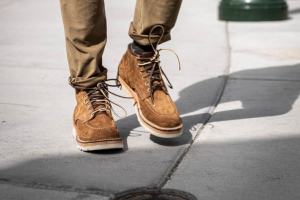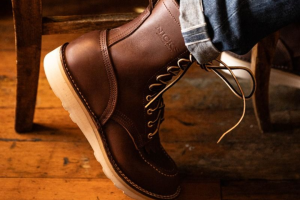What Height Should I Order For My Leather Work Boots?

Tall boots for structure, shorter for comfort...what height should I get for my leather work boots? If you have to choose, what's the best height to pick?
The quick answer is that it depends a bit on the application, but there are a few that will always work.
If you're going to invest in a quality pair of leather work boots you want to make sure they're going to work well for whatever you're doing!
We'll start with the three most popular boot heights. These three will always work, almost regardless of what you do for work, and also why. Then we'll go over some slightly less common boot heights and why those are worth considering as well...and why they're not.
With that said…
10-Inch Work Boots When You Want Protection

If you need or want to keep your lower legs protected due to the hazards of your job, 10-inch boots are more or less the standard.
10-inch boots are very popular as logger boots or firefighter boots, because they shield as much of the lower leg as possible without chafing at the calf; that's the reason why they're preferred for these trades as well as some others. That's also why they were the ordained boot height for paratrooper boots for decades.
Other jobs that likewise pose a danger of dinging the shin (or worse) due to materials or other hazards warrants some thought about lower leg protection. The 10-inch height is also a solid choice for construction and related trades, linesmen, and heavy manufacturing.
The additional shaft doesn't really add that much more stability or support to the boot; they just give you a little more real estate covering the lower leg.
8-Inch Work Boots: The Classic
An 8-inch boot is arguably the perfect medium. It's not so tall that your feet will overheat if worn indoors (depending on the boots you're wearing!) but isn't so short that you don't have protection or support.
The great thing about 8-inch boots is that the extra lacing sets the heel into the boot a little tighter, with a little more support than a shorter boot. While this comes at the cost of being a little warmer, it's not so bad that your feet boil on a warm day.
It's also the minimum boot height for wildland firefighters, and some opt for an 8-inch boot over a 10-inch because they're a little lighter. If you're looking for fire boots, this is where the NFPA-approved boots start.
The extra material also gives your lower leg a bit more protection.
Most work boots, hiking or hunting boots and so on are 8-inch boots by default, so this is the boot height that most people are used to. A lot of people find it serves most of their needs, unless they know for a fact that they need the extra material.
6-Inch Boots: The Goldilocks Boot?
Unless your job demands the utmost in protection and structure in footwear, 6-inch boots are a great choice as well.
The bootmaker can still give the boot all the structure needed to support the foot, but still make them light enough to be comfortable year 'round. Taller boots will be a lot warmer in the hot parts of the year.
That's why it's the de facto boot height for a lot of heritage boots and fashion boots.
Not that you can't wear 6-inch boots for work, and a lot of people do. A lot of people find they don't necessarily need a tall boot, but do need the comfort and support of a good work boot.
In fact, you'll find most of the popular factory work boot brands offer a lot of their boots in 6- and 8-inch boot heights, so there are a lot of trades that you're perfectly fine wearing one for.
If you don't need a heavy-duty work boot, but do need the comfort and support...it's a great choice. If you're buying a handcrafted pair of boots for everyday casual wear instead of work, this is probably the best choice.
Other Work Boot Heights

There are some other common work boot heights that you'll find out there, either as the height offered on various factory boots or if you're having made to order boots made. Let's go over some of them.
12-inch boots and taller are somewhat common for linesmen, railroad workers and other trades that require a lot more lower leg protection.
If you need a boot taller than 10 inches, you actually don't want to order a set height. Instead, what you should do is get fitted for taller-height boots in person. This is so you can find the boot height that sits just above the widest part of the calf.
Any shorter, and your boots are going to chafe your legs; any taller and they're pointless.
Therefore, get your legs measured by the bootmaker so you can wear them without discomfort. A lot of boots have been returned or sold on the used market because the owner got too tall or too short a boot that's taller than typical height.
9-inch and 7-inch boots are just slightly shorter than 10-inch and 8-inch boots, respectively. 9-inch boots are very common for hiking and hunting boots, so some people get hung up on that boot height.
If you find they work for you, then they are perfect. But in reality, there's nothing they do that an 8-inch or 10-inch boot doesn't. It's just slightly more or slightly less material.
5-inch boots, often called ankle boots, are the midway point between 6-inch boots and leather shoes. For some people, they're perfect. For others, they chafe the ankle. If you want the shortest possible boot without getting heavy shoes, try on a pair before committing.
There's good reasons for the most popular boot heights to be the standard. That said, if you feel you need a little less or a little more or happen to know that you do, choose wisely. A good tip is to get fitted or try a pair on before buying, so you know you're getting the right boots for you.





